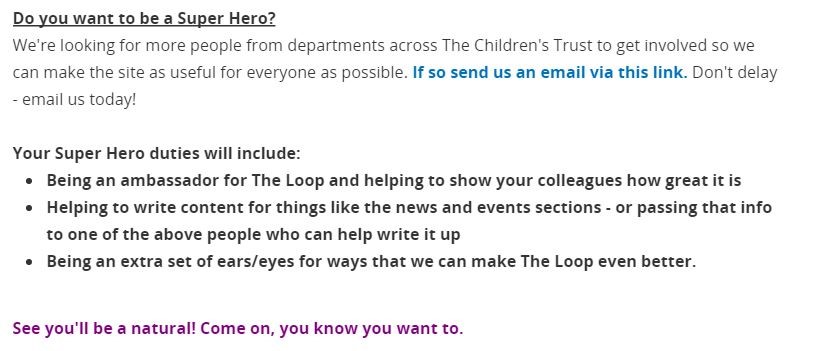Treating users as consumers: 5 top employee engagement tips
Intranets should be all about the users, and not designed just to suit the content author or the process owner, after all they are the consumers. Any intranet that isn’t designed, structured and managed with the end user in mind is not an intranet that is going to foster employee engagement.
1) Ask your users for feedback
It’s essential to get feedback from the end users, making the feedback channels easily accessible, focused and beneficial. This means it should be made clear that you welcome feedback, and more importantly, it is crucial that it is apparent you act on it.
It should also be focused. Don’t just ask users, “What do you think of the intranet?” as it is too broad and the range of answers you get will be too varied to be truly helpful. Instead ask a focused question, “What do you think of the user profile pages?” Give a reasonable amount of time for the feedback to be provided (a week should be long enough), but also give yourself time to read through it and take action as required.
2) Seeking feedback is not enough
It’s not a one way street so you should also look to give feedback to users. This is a lot easier to do if employees know what is expected of them in the first place, and they are aware of the part they have to play in the intranet’s success.
It is a good idea to acknowledge and reward those that are doing what you want them to do. It doesn’t have to cost anything and it has the huge benefit of increasing employee engagement by making the user feel good, as well as further publicising and reinforcing the behaviour you wish to occur. A fundamental principle of psychology is that “behavior that is rewarded is repeated.” In this case not only by the person being thanked, but also by others that see behaviour being demonstrated and rewarded.
3) When you set intranet objectives don’t just focus on quantity
It’s not sufficient enough to have content being liked as an indication of collaboration, you need to make it clear why that action is desired and what the benefits are of it. Then, when it happens, it is good to acknowledge it as it’ll occur more frequently and widely.
At Interact, on our intranet, Homer, these rewards manifest themselves as a ‘shield’ that is assigned to a user’s profile (by way of an additional field) when they have undertaken certain activities.
Interacters become a member of ‘Interact Academy Level 1’ once they have completed key activities:
 (We have Level 2 and Level 3 that are achieved when further behaviours are shown and activities completed that build on Level 1).
(We have Level 2 and Level 3 that are achieved when further behaviours are shown and activities completed that build on Level 1).
4) Locate your Superheroes
There are a number of different user groups in any intranet. There will be those who add and maintain content. For this group you could look at what they are doing to create and care for content and processes, and then reward them for doing so in a user-focused way.
The Children’s Trust do this on their intranet, The Loop, by recognising “Loop Super Heroes” (this too is done by displaying an additional field on their profile page). As well as identifying current Superheroes they also encourage new members and highlight what a Superhero does:
 Defining the expected behaviour and roles and responsibilities underpins the idea of having ‘Success Partners’. These are those users that have some responsibility towards ensuring the intranet is a success by behaving in a way that contributes to the achievement of intranet objectives.
Defining the expected behaviour and roles and responsibilities underpins the idea of having ‘Success Partners’. These are those users that have some responsibility towards ensuring the intranet is a success by behaving in a way that contributes to the achievement of intranet objectives.
5) Treat all users as Success Partners
In effect all users are Success Partners, it’s just what they need to do that differs. For instance, you may talk to the IT team about the part they can play in the intranet’s success by checking the data that is going to be used to populate user profiles is up-to-date. For the HR Success Partners it might be about presenting the answers to common HR FAQs in a user-friendly, concise way. For the Finance team it might be about encouraging them to review the ease of use of common financial forms. Being a role model is also a key behaviour of a Success Partner, so it should include the senior management team by showing them what is expected of them and ensuring that they are aware and able to do what is needed to be the role models of user behaviour.
Of course having identified the desired behaviour it is important that when demonstrated it too is acknowledged. Often a ‘thank you’ is a cost effective and powerful reward.
So on that note, thank you for reading this blog and if you have any feedback or thoughts I would be happy to discuss them with you – contact me via Steven_Osborne.
